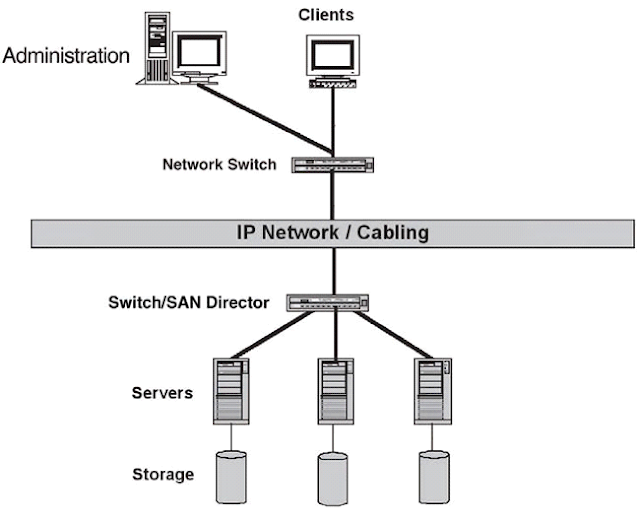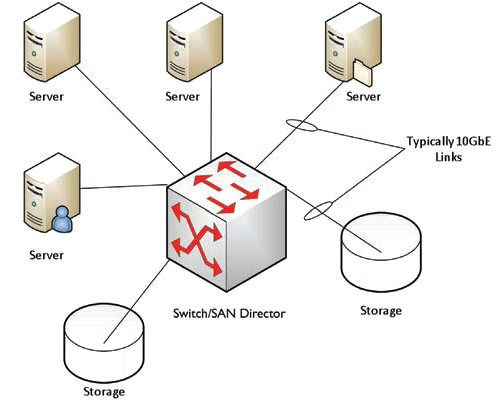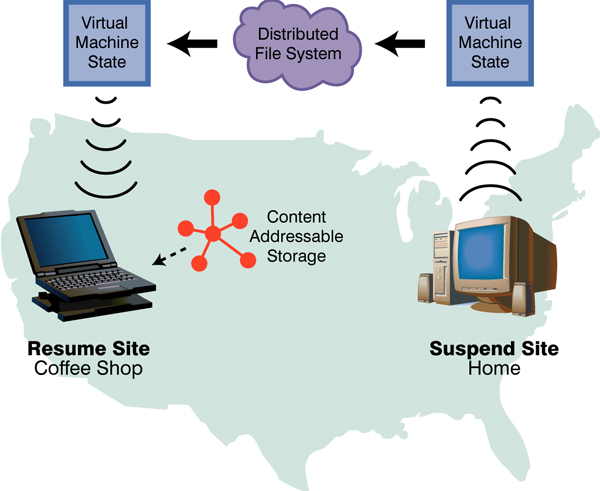MANAGEMENT OF DAS, NAS, CAS & SAN
1.
Management of DAS:
- DAS is the traditional method of
locally attaching storage devices to servers via a direct communication
path between the server and storage devices.
- As shown in Figure 1, the
connectivity between the server and the storage devices are on a dedicated
path separate from the network cabling.
- Access is provided via an
intelligent controller. The storage can only be accessed through the
directly attached server.
- This method was developed
primarily to address shortcomings in drive-bays on the host computer
systems.
- When a server needed more drive
space, a storage unit was attached. This method also allowed for one
server to mirror another.
- The mirroring functionality may
also be accomplished via directly attached server to server interfaces.
- A disk
subsystem that is directly connected to a host rather than going through a
switched network, thereby giving the host exclusive access to the disks.
- The
category obviously includes disks internal to a physical server, but in
the storage realm we most often think about JBOD (“just a bunch of disks”)
shelves attached to a server via SAS cable.
Figure 1: A
Simple DAS Diagram
2.
Management Of NAS:
- Network
Attached Storage is a backup and storage system that is used within
organizations that have a large number of departments that require storage
of large amounts of data on a central server.
- With
Network Attached Storage the data storage is configured with its own
network address instead of being associated with the department server and
the department computer.
- A
system that does not have Network Attached Storage has the hard diak data
storage located on the department server which is attached to the
department computer. This type of set up can significantly slow down the
processing speed of the applications that are delivered to all of the
workstations on the network.
- With
a Network Attached Storage System the hard disk storage access is located
separate from the department server with an exclusive network IP address
on a local area network.
- This
allows faster service on the department server for file transfer and
business software applications. Data can still be accessed by the client
workstations through a file request map that is channeled to the Network
Attached Storage system on the local area network server.
Figure 2:
Simple NAS Architecture
3.
Management Of CAS:
- CAS is a way of storing information that can be retrieved based on its content, instead of its storage location.
- It’s typically used for long-term
storage and retrieval of fixed content, like documents stored with
compliance for government regulations, or medical records like x-rays and
MRIs.
- In other words, when you think
about storage, everything has an address. For conventional file systems,
it’s a name and a location in a hierarchy of directories.
- A CAS system uses the content
itself as an address through a unique identifier, typically using a
hashing algorithm performed against the content. That makes the content
address unique. No two pieces of content have the same address unless the
content is exactly the same.
- When a content address is provided to the device, it first queries the
directory for the physical location of the specified content address. The
information is then retrieved from a storage node, and the actual hash of
the data recomputed and verified. Once this is complete, the device can
supply the requested data to the client.
Figure 3: CAS
Architecture
4.
Management Of SAN:
- SAN (storage area network) is
a high-speed network of storage devices that also connects those storage
devices with servers.
- It provides block level storage that can be accessed by the
applications running on any networked servers.
- SAN storage devices can include tape libraries and disk-based devices,
like RAID hardware. SANs are particularly helpful in backup and
disaster recovery settings. Within a SAN, data can be transferred from one
storage device to another without interacting with a server.
- This speeds up the backup process and eliminates the need to use
server CPU cycles for backup. Many SANs utilize Fibre Channel technology
or other networking protocols that allow the networks to span longer
distances geographically. That makes it more feasible for companies to
keep their backup data in remote locations.
- Utilizing a SAN can also simplify some management tasks, potentially allowing organizations to hire fewer IT workers or to free up some IT workers for other tasks.
- It’s also possible to boot servers from a SAN,
which can reduce the time and hassles involved in replacing a server
Figure 4: Simple SAN Architecture


